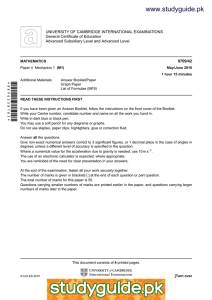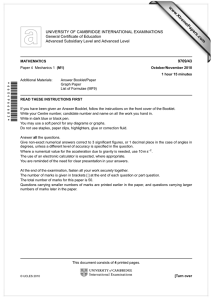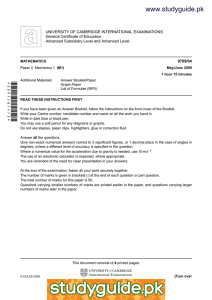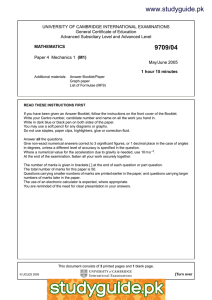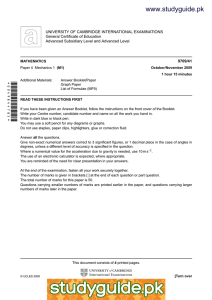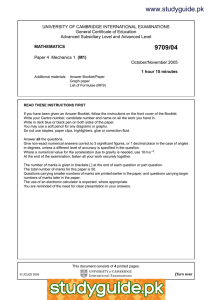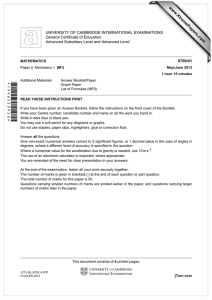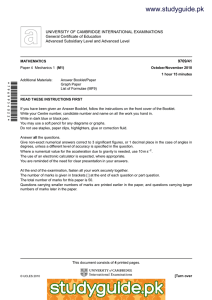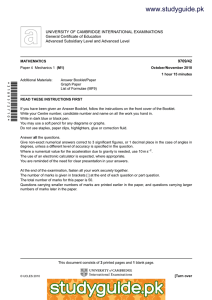www.studyguide.pk
advertisement
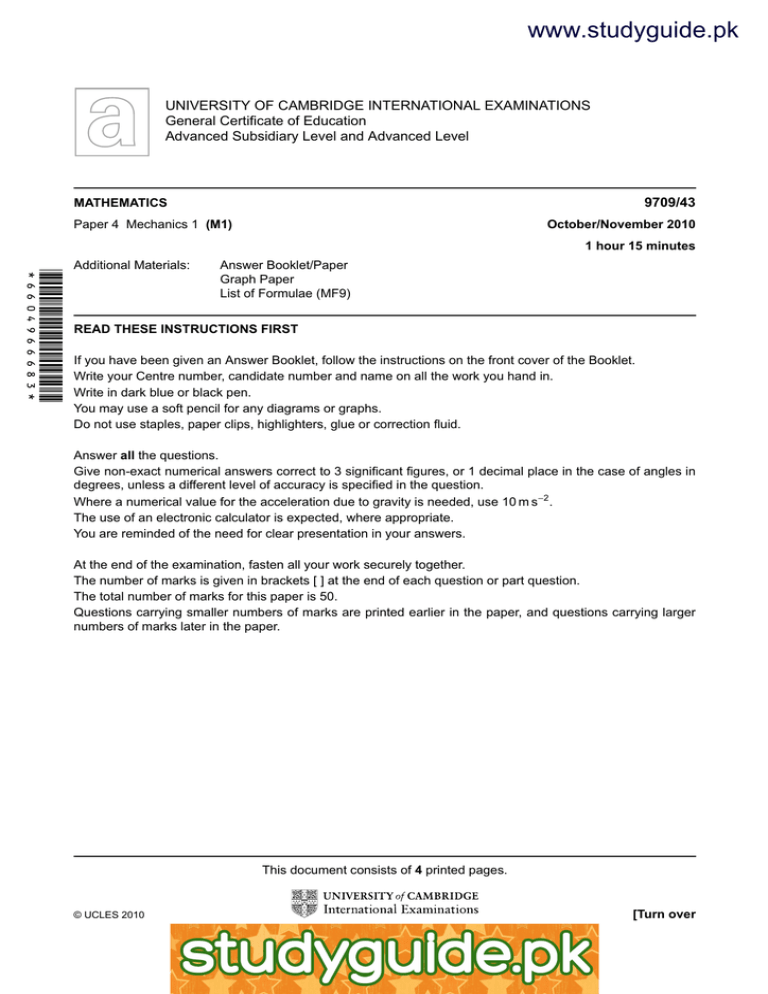
www.studyguide.pk UNIVERSITY OF CAMBRIDGE INTERNATIONAL EXAMINATIONS General Certificate of Education Advanced Subsidiary Level and Advanced Level 9709/43 MATHEMATICS Paper 4 Mechanics 1 (M1) October/November 2010 1 hour 15 minutes *6604966683* Additional Materials: Answer Booklet/Paper Graph Paper List of Formulae (MF9) READ THESE INSTRUCTIONS FIRST If you have been given an Answer Booklet, follow the instructions on the front cover of the Booklet. Write your Centre number, candidate number and name on all the work you hand in. Write in dark blue or black pen. You may use a soft pencil for any diagrams or graphs. Do not use staples, paper clips, highlighters, glue or correction fluid. Answer all the questions. Give non-exact numerical answers correct to 3 significant figures, or 1 decimal place in the case of angles in degrees, unless a different level of accuracy is specified in the question. Where a numerical value for the acceleration due to gravity is needed, use 10 m s−2 . The use of an electronic calculator is expected, where appropriate. You are reminded of the need for clear presentation in your answers. At the end of the examination, fasten all your work securely together. The number of marks is given in brackets [ ] at the end of each question or part question. The total number of marks for this paper is 50. Questions carrying smaller numbers of marks are printed earlier in the paper, and questions carrying larger numbers of marks later in the paper. This document consists of 4 printed pages. [Turn over © UCLES 2010 www.XtremePapers.net www.studyguide.pk 2 1 A particle P is released from rest at a point on a smooth plane inclined at 30◦ to the horizontal. Find the speed of P (i) when it has travelled 0.9 m, (ii) 0.8 s after it is released. [4] 2 A 1.8 m C B The diagram shows the vertical cross-section ABC of a fixed surface. AB is a curve and BC is a horizontal straight line. The part of the surface containing AB is smooth and the part containing BC is rough. A is at a height of 1.8 m above BC . A particle of mass 0.5 kg is released from rest at A and travels along the surface to C. (i) Find the speed of the particle at B. [2] (ii) Given that the particle reaches C with a speed of 5 m s−1 , find the work done against the resistance to motion as the particle moves from B to C . [2] 3 A Q P 3 Ö3 N B 30° C A small smooth pulley is fixed at the highest point A of a cross-section ABC of a triangular prism. Angle ABC = 90◦ and angle BCA = 30◦ . The prism is fixed with the face containing BC in contact with a horizontal surface. Particles P and Q are attached to opposite ends of a light inextensible string, which passes over the pulley. The particles are in equilibrium with P hanging vertically below √ the pulley and Q in contact with AC. The resultant force exerted on the pulley by the string is 3 3 N (see diagram). (i) Show that the tension in the string is 3 N. [2] The coefficient of friction between Q and the prism is 0.75. (ii) Given that Q is in limiting equilibrium and on the point of moving upwards, find its mass. © UCLES 2010 9709/43/O/N/10 www.XtremePapers.net [5] www.studyguide.pk 3 4 A particle starts from rest at a point X and moves in a straight line until, 60 seconds later, it reaches a point Y . At time t s after leaving X , the acceleration of the particle is 0.75 m s−2 for −2 0 < t < 4, for −0.5 m s−2 4 < t < 54, for 54 < t < 60. 0ms (i) Find the velocity of the particle when t = 4 and when t = 60, and sketch the velocity-time graph. [5] (ii) Find the distance XY . 5 [2] A force of magnitude F N acts in a horizontal plane and has components 27.5 N and −24 N in the x-direction and the y-direction respectively. The force acts at an angle of α ◦ below the x-axis. (i) Find the values of F and α . [4] A second force, of magnitude 87.6 N, acts in the same plane at 90◦ anticlockwise from the force of magnitude F N. The resultant of the two forces has magnitude R N and makes an angle of θ ◦ with the positive x-axis. (ii) Find the values of R and θ . 6 [3] A particle travels along a straight line. It starts from rest at a point A on the line and comes to rest again, 10 seconds later, at another point B on the line. The velocity t seconds after leaving A is 0.72t2 − 0.096t3 2.4t − 0.24t 2 for 0 ≤ t ≤ 5, for 5 ≤ t ≤ 10. (i) Show that there is no instantaneous change in the acceleration of the particle when t = 5. [4] (ii) Find the distance AB. [4] [Question 7 is printed on the next page.] © UCLES 2010 9709/43/O/N/10 www.XtremePapers.net [Turn over www.studyguide.pk 4 7 A car of mass 1250 kg travels along a horizontal straight road. The power of the car’s engine is constant and equal to 24 kW and the resistance to the car’s motion is constant and equal to R N. The car passes through the point A on the road with speed 20 m s−1 and acceleration 0.32 m s−2 . (i) Find the value of R. [3] The car continues with increasing speed, passing through the point B on the road with speed 29.9 m s−1 . The car subsequently passes through the point C . (ii) Find the acceleration of the car at B, giving the answer in m s−2 correct to 3 decimal places. [2] (iii) Show that, while the car’s speed is increasing, it cannot reach 30 m s−1 . [2] (iv) Explain why the speed of the car is approximately constant between B and C. [1] (v) State a value of the approximately constant speed, and the maximum possible error in this value at any point between B and C. [1] The work done by the car’s engine during the motion from B to C is 1200 kJ. (vi) By assuming the speed of the car is constant from B to C, find, in either order, (a) the approximate time taken for the car to travel from B to C, (b) an approximation for the distance BC. [4] Permission to reproduce items where third-party owned material protected by copyright is included has been sought and cleared where possible. Every reasonable effort has been made by the publisher (UCLES) to trace copyright holders, but if any items requiring clearance have unwittingly been included, the publisher will be pleased to make amends at the earliest possible opportunity. University of Cambridge International Examinations is part of the Cambridge Assessment Group. Cambridge Assessment is the brand name of University of Cambridge Local Examinations Syndicate (UCLES), which is itself a department of the University of Cambridge. © UCLES 2010 9709/43/O/N/10 www.XtremePapers.net
